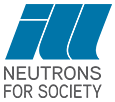The NEPHEWS Twinning Programme gives researchers the opportunity to gain hands-on experience with neutron experiments at the ILL and to learn directly from beamline scientists. Participants benefit from short placements that combine observation, practical training, and guidance on how to integrate neutron techniques into their own research.
Two recent participants took part in experiments on the IN1-Lagrange spectrometer, observing and contributing to live experiments on zeolites.
Giorgia Cariati from the Instituto de Tecnología Química, UPV–CSIC, Spain “Taking part in the NEPHEWS Programme enabled me to see how the technique works in practice and to understand its potential,” Giorgia explains. “It has helped me identify how best to integrate it into my research and to plan future experiments more effectively.” Giorgia now plans to attend the ADD2026 School, jointly organised in January 2026 by the ESRF and the ILL, to strengthen her data analysis skills and build on what she learned during her stay. |
Morgana, whose PhD research focuses on 2D materials and gas sensors, participated in an experiment on the role and mapping of surface H⁺ and Al sites on zeolites for SAF-range olefin production. Her goal was to gain hands-on exposure to neutron techniques and to connect them to her previous work on adsorption phenomena. "The best part about this programme is the care taken to involve the student in an experiment in a similar area to one we have already worked on. For example, I had already worked with adsorption and I followed a researcher in an inelastic neutron scattering analysis for adsorption. So it’s a great way to start in the field” she adds. |
“Inelastic neutron scattering (INS) is ideal to study zeolites. Indeed, neutrons are particularly good at ‘seeing’ individual hydrogen atoms and can detect all the molecular vibrational modes where the H atoms are involved.
The analysis of inelastic neutron scattering data allows us to extract precise information on molecular vibrations – especially those associated with hydrogen atoms – and opens the way to understanding the dynamics of specific atoms or molecules and of the surrounding chemical environment disturbing them,” says Monica Jimenez-Ruiz, ILL scientist and IN1-Lagrange Instrument Responsible.
Giorgia’s and Morgana’s experiences demonstrate how NEPHEWS supports both deepening existing expertise and exploring new scientific directions. Through hands-on training, mentoring, and the chance to work directly on the IN1-Lagrange spectrometer, both gained a clearer understanding of neutron techniques while strengthening their connection with the international materials science community.
The NEPHEWS Twinning Programme still welcomes applications and continues to play a vital role in preparing researchers to make full use of Europe’s complementary advanced neutron, synchrotron and free-electron laser research infrastructures, to promote curiosity-driven excellence in research.



